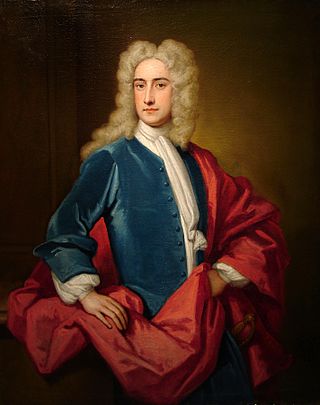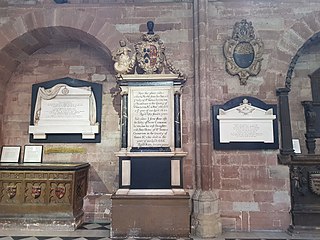Related Research Articles

The Battle of Worcester took place on 3 September 1651 in and around the city of Worcester, England and was the last major battle of the 1642 to 1651 Wars of the Three Kingdoms. A Parliamentarian army of around 28,000 under Oliver Cromwell defeated a largely Scottish Royalist force of 16,000 led by Charles II of England.
Sir Henry Herbert was Master of the Revels to both King Charles I and King Charles II, as well as a politician during both reigns.

Baron Sandys is a title that has been created three times, once in the Peerage of England, once in the Peerage of Great Britain and once in the Peerage of the United Kingdom.

Henry Somerset, 1st Marquess of Worcester was an English aristocrat, who was a prominent and financially important Royalist during the early years of the English Civil War.

Sir Thomas Lyttelton, 1st Baronet was an English Royalist officer and politician from the Lyttelton family during the English Civil War.

The second and longest siege of Worcester took place towards the end of the First English Civil War, when Parliamentary forces under the command of Thomas Rainsborough besieged the city of Worcester, accepting the capitulation of the Royalist defenders on 22 July. The next day the Royalists formally surrendered possession of the city and the Parliamentarians entered Worcester 63 days after the siege began.

The Battle of Stow-on-the-Wold took place during the First English Civil War. It was a Parliamentarian victory by detachments of the New Model Army over the last Royalist field army.
1646 was the fifth and final year of the First English Civil War. By the beginning of 1646 military victory for the Parliamentary forces was in sight. A Royalist army was defeated in the field at the Battle of Torrington on 16 February and the last Royalist field army was defeated at the Battle of Stow-on-the-Wold on 21 March. From then on the New Model Army cleared the remaining Royalist strongholds. The politics moved into a post-war phase with all the major factions in England and Scotland trying to reach an accommodation with King Charles I that would further their own particular interests.

Worcestershire was the county where the first battle and last battle of the English Civil War took place. The first battle, the Battle of Powick Bridge, fought on 23 September 1642, was a cavalry skirmish and a victory for the Royalists (Cavaliers). The final battle, the battle of Worcester, fought on 3 September 1651, was decisive and ended the war with a Parliamentary (Roundhead) victory and King Charles II a wanted fugitive.

John William Bund Willis-Bund was a British lawyer, legal writer and professor of constitutional law and history at King's College London, a historian who wrote on the Welsh church and other subjects, and a local Worcestershire politician.
Governors of the city of Worcester, England, include:
Sir William Russell, 1st Baronet, of Wytley, was an English politician who sat in the House of Commons in 1625. He was an officer in the Royalist army during the English Civil War and, as Governor of Worcester, he refused entry to the Parliamentary cavalry shortly before the Battle of Powick Bridge — the first cavalry skirmish of the Civil War.
Captain Sir Thomas Liddell, 1st Baronet (1578–1652) was an English politician, a member of the Liddell family which monopolized the local government of the North of England during the 16th and 17th centuries. He was one of the leading supporters of the Royalist cause in the English Civil War.
Fitzwilliam Coningsby was an English politician who sat in the House of Commons in 1621 and in 1640. He supported the Royalist cause in the English Civil War.
Colonel Sir Gilbert Gerard was a Royalist officer during the English Civil War.

The Battle of Ripple Field, fought on 13 April 1643, was an engagement in the First English Civil War. In the battle, a Royalist cavalry force led by Prince Maurice routed Parliamentarian cavalry and infantry forces led by Sir William Waller.
The Battle of Stourbridge Heath was a skirmish that took place during the First English Civil War, in which a Parliamentarian contingent under the command of Colonel "Tinker" Fox was defeated by a larger Royalist force under the command of Sir Gilbert Gerard, Governor of Worcester.

The short siege of Worcester was conducted by a Parliamentary army of about 3,000 under the command of Sir William Waller. They failed to capture the city, which was defended by about 1,700 Royalists under the command of Colonel William Sandys the acting governor, and retreated back to the Parliamentary stronghold of Gloucester.
Colonel Henry Sandys, 5th Baron Sandys, was an English nobleman and Cavalier officer in the English Civil War.
Thomas Sandys, 2nd Baron Sandys, was an English peer.
References
- Banks, Thomas Christopher (1808), The Dormant and Extinct Baronage of England: Or, An Historical and Genealogical Account of the Lives, Public Employments, and Most Memorable Actions of the English Nobility who Have Flourished from the Norman Conquest, J. White, p. 456
- Burke, John (1846), A General and Heraldic Dictionary of the Peerages of England, Ireland, and Scotland, extinct, dormant, and in abeyance ... England, Henry Colburn, p. 464
- Willis-Bund, John William (1905), The Civil War In Worcestershire, 1642-1646: And the Scotch Invasion Of 1651, Birmingham: The Midland Educational Company